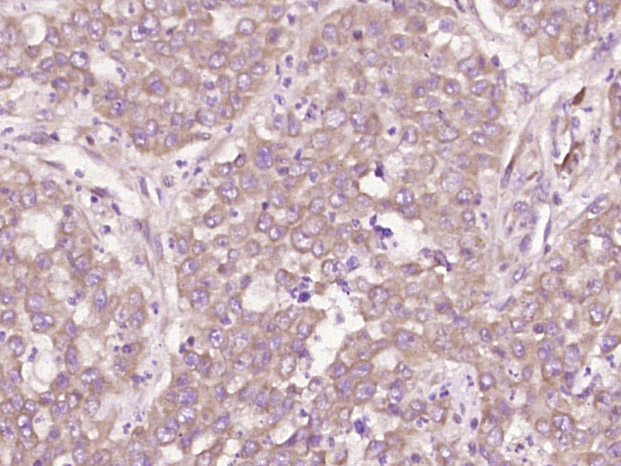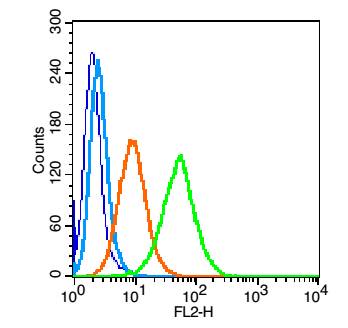
Rabbit Anti-CD97 antibody
CD97 antigen subunit beta; Leukocyte antigen CD97; CD 97; CD97; CD97 antigen; CD97 molecule; CD97_HUMAN; Leukocyte antigen CD97; Seven span transmembrane protein; Seven transmembrane helix receptor; Seven transmembrane heterodimeric receptor associated wi
View History [Clear]
Details
Product Name CD97 Chinese Name CD97抗体 Alias CD97 antigen subunit beta; Leukocyte antigen CD97; CD 97; CD97; CD97 antigen; CD97 molecule; CD97_HUMAN; Leukocyte antigen CD97; Seven span transmembrane protein; Seven transmembrane helix receptor; Seven transmembrane heterodimeric receptor associated with inflammation; TM7LN 1; TM7LN1. Research Area immunology Neurobiology The cell membrane受体 Cell adhesion molecule G protein-coupled receptor Cell Surface Molecule glycoprotein Immunogen Species Rabbit Clonality Polyclonal React Species Human, (predicted: Mouse, Rat, Dog, Pig, Cow, ) Applications ELISA=1:5000-10000 IHC-P=1:100-500 IHC-F=1:100-500 Flow-Cyt=1μg/Test IF=1:100-500 (Paraffin sections need antigen repair)
not yet tested in other applications.
optimal dilutions/concentrations should be determined by the end user.Theoretical molecular weight 34/92kDa Cellular localization The cell membrane Extracellular matrix Secretory protein Form Liquid Concentration 1mg/ml immunogen KLH conjugated synthetic peptide derived from human CD97 antigen subunit beta: 741-835/835 <Cytoplasmic> Lsotype IgG Purification affinity purified by Protein A Buffer Solution 0.01M TBS(pH7.4) with 1% BSA, 0.03% Proclin300 and 50% Glycerol. Storage Shipped at 4℃. Store at -20 °C for one year. Avoid repeated freeze/thaw cycles. Attention This product as supplied is intended for research use only, not for use in human, therapeutic or diagnostic applications. PubMed PubMed Product Detail This gene encodes a member of the EGF-TM7 subfamily of adhesion G protein-coupled receptors, which mediate cell-cell interactions. These proteins are cleaved by self-catalytic proteolysis into a large extracellular subunit and seven-span transmembrane subunit, which associate at the cell surface as a receptor complex. The encoded protein may play a role in cell adhesion as well as leukocyte recruitment, activation and migration, and contains multiple extracellular EGF-like repeats which mediate binding to chondroitin sulfate and the cell surface complement regulatory protein CD55. Expression of this gene may play a role in the progression of several types of cancer. Alternatively spliced transcript variants encoding multiple isoforms with 3 to 5 EGF-like repeats have been observed for this gene. This gene is found in a cluster with other EGF-TM7 genes on the short arm of chromosome 19. [provided by RefSeq, Jun 2011].
Function:
Receptor potentially involved in both adhesion and signaling processes early after leukocyte activation. Plays an essential role in leukocyte migration.
Subunit:
Forms a heterodimer, consisting of a large extracellular region (alpha subunit) non-covalently linked to a seven-transmembrane moiety (beta subunit). Interacts with complement decay-accelerating factor (DAF). The largest isoform (isoform 1) interacts with chondroitin sulfate.
Subcellular Location:
Cell membrane; Multi-pass membrane protein.
CD97 antigen subunit alpha: Secreted, extracellular space.
Tissue Specificity:
Broadly expressed, found on most hematopoietic cells, including activated lymphocytes, monocytes, macrophages, dendritic cells, and granulocytes. Expressed also abundantly by smooth muscle cells. Expressed in thyroid, colorectal, gastric, esophageal and pancreatic carcinomas too. Expression are increased under inflammatory conditions in the CNS of multiple sclerosis and in synovial tissue of patients with rheumatoid arthritis. Increased expression of CD97 in the synovium is accompagnied by detectable levels of soluble CD97 in the synovial fluid.
Post-translational modifications:
Proteolytically cleaved into 2 subunits, an extracellular alpha subunit and a seven-transmembrane subunit.
Similarity:
Belongs to the G-protein coupled receptor 2 family. LN-TM7 subfamily.
Contains 5 EGF-like domains.
Contains 1 GPS domain.
SWISS:
P48960
Gene ID:
976
Database links:Entrez Gene: 976 Human
Entrez Gene: 26364 Mouse
Omim: 601211 Human
SwissProt: P48960 Human
SwissProt: Q9Z0M6 Mouse
Unigene: 466039 Human
Unigene: 334648 Mouse
Unigene: 107655 Rat
Product Picture
Primary Antibody:Rabbit Anti-CD97 antibody(SL2522R), Dilution: 1μg in 100 μL 1X PBS containing 0.5% BSA;
Isotype Control Antibody: Rabbit IgG(orange) ,used under the same conditions );
Secondary Antibody: Goat anti-rabbit IgG-PE(white blue), Dilution: 1:200 in 1 X PBS containing 0.5% BSA.
References (0)
No References
Bought notes(bought amounts latest0)
No one bought this product
User Comment(Total0User Comment Num)
- No comment




 +86 571 56623320
+86 571 56623320
 +86 18668110335
+86 18668110335

